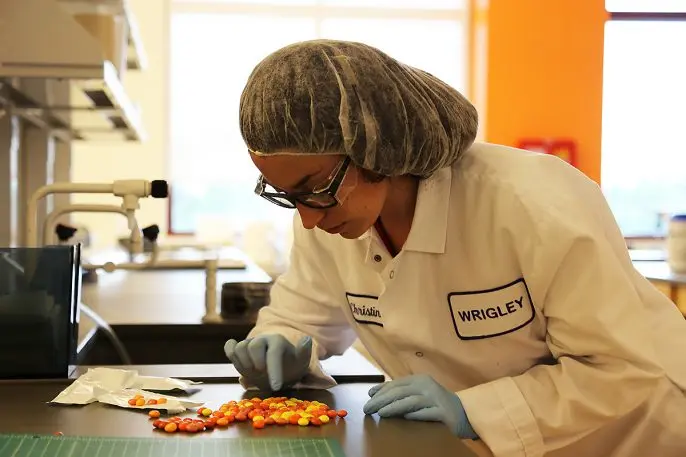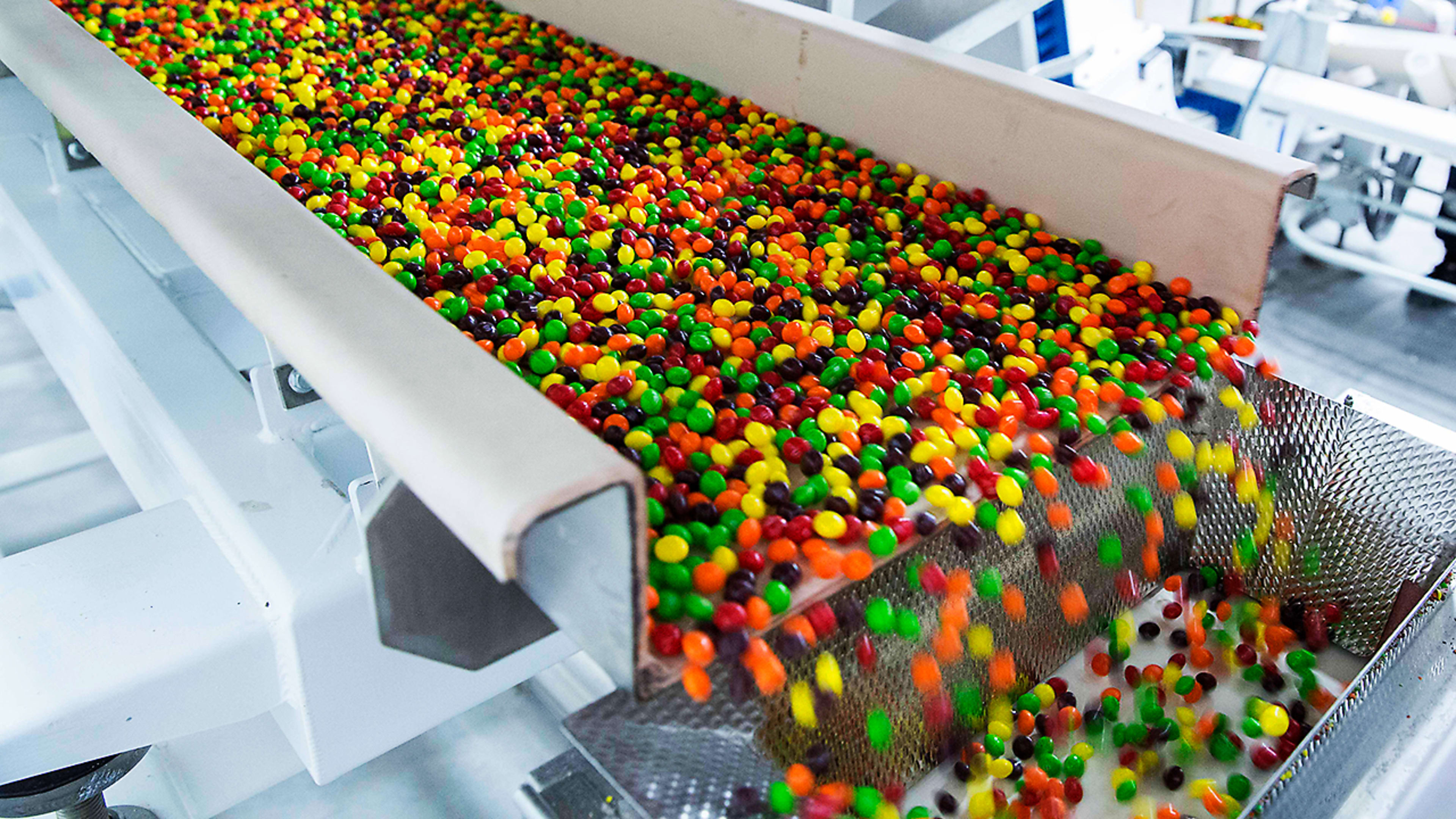You might say that Chrissy Jilek hit the sweet spot between passion and enthusiasm when she landed a job as associate product development scientist at Wrigley North America three years ago. You know: Juicy Fruit, Doublemint, Lifesavers–that Wrigley. What’s more is that by the end of this year, two new kinds of old favorite candies “Sweet Heat” Skittles and Starburst will make their debut thanks directly to the 26-year old’s work.
“I didn’t even think that could be a job,” Jilek admits when recalling the beginning of her journey.

To be fair, when most of us think of making candy, it’s hard not to conjure the colorful world of Willy Wonka and his magical manufacturing facility. But many don’t have an inkling of how a product comes to be, much less how it gets made. Jilek was no different.
“Like every other kid, I loved candy and I loved food,” she says with a laugh, adding, “I also loved science.” An astute family member clued in to her twin interests and suggested that she pursue food science in college. Once at University of Wisconsin Madison, Jilek landed summer internships, first at a dairy plant, and then at Wrigley.
Jilek also built up an extensive industry network by getting involved with Institute of Food Technologists Student Association (IFTSA), American Association of Candy Technologists (AACT) and Professional Manufacturing Confectioners Association (PMCA). “I participated in product development competitions with IFTSA and received a scholarship from AACT,” she points out.
By the time she graduated, Jilek had a job offer from the venerable 126-year old confectioner. That’s due in part to the internship program, which has students working on actual projects alongside regular employees. “You get assigned a project that you will have a clear deliverable for by the end of your 12 weeks,” she explains. Jilek’s was in research and development.
That means she (and others) donned the hair nets, lab coats, and steel-toed shoes and dove right in to “play with the formulas, play with the products, and create a detailed report that gets utilized by the rest of the company.” Jilek points out that one of the other interns in her cohort was able to contribute to the creation of a new kind of gum.

“From the younger product developers to senior leaders, people were excited to share their professional experience and advice,” Jilek says. “The office was open, collaborative and fun,” she continues, “the community setting encourages connection.”
And that community is a huge one. Wrigley alone employs approximately 15,000 associates globally across 50 countries. Its distribution spans about 765 products in more than 180 countries and operates as a subsidiary of the larger chocolate (and pet care, food, beverage, and other products) company, Mars, Inc. that logged net sales of more than $35 billion. Because the company is privately held–and food science is such a secretive business– there are plenty of subjects Jilek has to skim to retain confidentiality.
What Jilek does share is that after just wrapping up her time in Wrigley’s R&D rotational program, the manager on her confections team approached her about creating a new product. “Sweet Heat (Skittles) had been in the works before I came on,” Jilek explains, as there had been some consumer testing and concept building. But now Wrigley was ready to “knock it out the door and be the leaders in a spicy and sweet confection,” she says.
And no wonder. Even if you’re not in the food industry, you’ve certainly noticed the preponderance of spicy foods populating grocery store shelves and restaurant menus. More than three-quarters (78%) of consumers say they enjoy at least moderately spicy foods, and more than half (55%) typically crave spicy food flavors, according to the most recent Techomic’s food trend report. From Hot Cheetos to Ghost Pepper Burgers, to a growing number of varieties of hot sauce–itself a $1 billion market which has been dubbed the “go-to condiment” for millennials— it’s not hard to see why Wrigley was motivated to appeal to a younger, heat-seeking consumer, albeit with a twist.
“From flavors like honey sriracha to mango chipotle, confectioners and snack manufacturers both are increasingly turning to sweet to balance out hot, spicy, or tangy flavors,” said Susan Whiteside, vice president of public relations and marketing communications for the National Confectioners Association at a recent industry conference. “We’ve certainly seen some of that in the candy industry before with Red Hots and Atomic Fireball, but this is taking those flavors to the next level and really experimenting with different heat sources as well as different sweet sources.”
Who better than a millennial to lead the charge? So even though it was her first week on the job, Jilek rolled up her sleeves and readied her palate and got ready to “play with spice.” That meant formulated testing and tasting a variety of flavor combinations and degrees of intensity internally before trotting it out to pilot groups of consumers.
“Heat is personal,” Jilek underscores, admitting she herself doesn’t seek out spicy foods. But that isn’t necessarily a problem for two reasons. “In product development it doesn’t matter what you like,” she explains. “I have the luxury of trying but it’s never just for me,” Jilek says. However she did learn how to tolerate the burn pretty quickly during the development process and points out that a candy like Skittles is perfect for sampling and adjusting heat. “You can have just one or a handful,” says Jilek.
The other is that she was working on a team of 10-15 people to launch Sweet Heat. The team was made up of people serving many different functions across R&D, marketing, finance, and more across the company. Additionally, one of her team members, product development scientist Andy Renaud, stepped up to serve as Jilek’s mentor to help guide the process. “Because it was my first time leading the development of a product from start to finish, he supported me–offering advice, sharing experience, and always making himself available to answer questions,” she explains. “He also started his journey [a few years before me] with Wrigley in the R&D rotational program.”
The trials and tests resulted in the final group of flavors that include Sweet Heat Skittles Fiery Watermelon, Blazin’ Mango, Flamin’ Orange, Sizzlin’ Strawberry and Lemon Spark and the Starburst versions in Fiery Watermelon, Strawberry Mango, Flamin’ Orange, and Pipin’ Pineapple. (Her favorite so far is Fiery Watermelon.)
All told, the process took about a year until Jilek saw the first fruits of her labor roll off the factory belt. Sweet Heat Skittles and Starburst made their first appearance at the Sweets & Snacks Expo in late May in Chicago, but won’t actually hit store shelves until winter.
As for Jilek, she’ll be watching to see how well they perform, but she’s already working on other projects. “My journey has come full circle,” she observes, “This summer, I’m serving as a mentor for our summer interns. It feels like just yesterday I was in their shoes–or steel-toe shoes to be exact.”
Recognize your brand’s excellence by applying to this year’s Brands That Matter Awards before the early-rate deadline, May 3.
